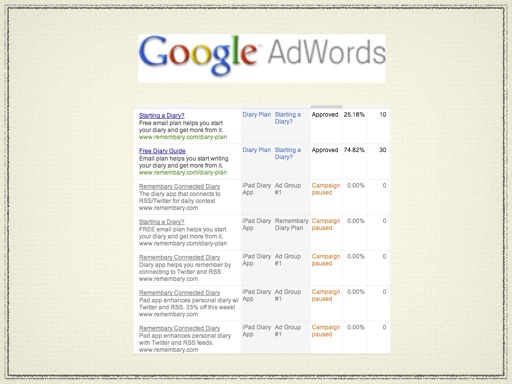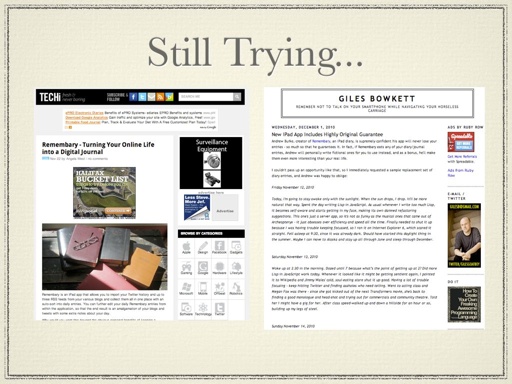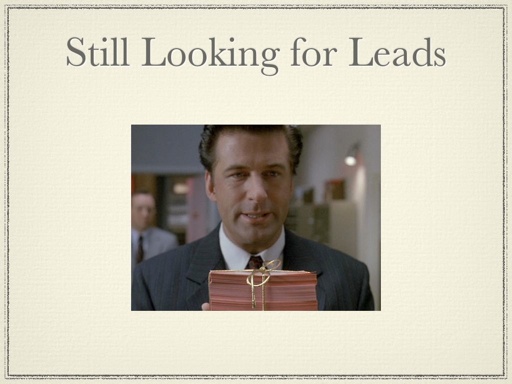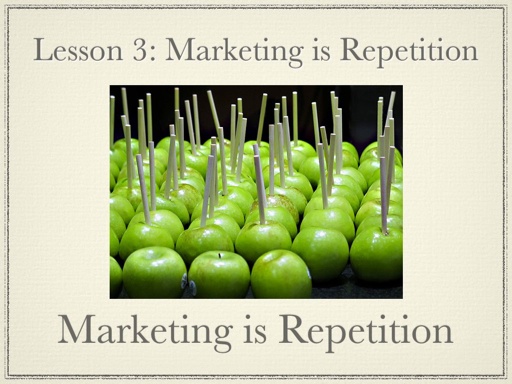PodCampHFX Remembary Presentation Part 2
Feb 24, 2011 14:01
On January 23rd 2011, I gave a talk at PodCamp Halifax about my experiences in building my first iOS app, Remembary, and the first few months of trying to promote it. It was called "Why You Should Have an App in the App Store Even If You Probably Won't Make Any Money".
In Part 1, I talked about building Remembary and launching it in the store. Now, here are some of the things I learned.
Lesson 1: It's a Very Long Tail
It's an achievement to get an app into the app store, but it's just the beginning. Just having an app isn't enough. In fact, the App Store is crowded with apps built by people who thought that simply getting an app into the store was enough. There's been a lot of talk about the new world of endless media, without the middle-men. This is the new world of the Long Tail. Here's another way to look at it. Every book you see at a book store or library was selected by someone at a publishing house. For every one of these books, there are dozens or hundreds or thousands of manuscripts that never made it. People devote months or years of their lives to producing a manuscript, which they then send (often blindly!) to a publisher in hope of getting noticed - and most of these manuscripts are put it into a "slush pile". This slush pile is occasionally flipped through by poorly-paid interns.
In The App Store, the default is to be in the Slush Pile. There's no filter, so the bottom end of the App Store is filled with mediocrity and abandonware. Anyone can submit an app - and as long as it isn't terribly buggy or otherwise violating the App Store guidelines, it will become part of the App Store collection. A lot of people finish building an app and then discover that simply being in the App Store won't instantly make them rich - so they give up. But their app doesn't disappear: it stays in the App Store, floating at the bottom of the Slush Pile.
And by default, the slush pile is where your app lives, too.
Here's another way to look at it. Every book you see at a book store or library was selected by someone at a publishing house. For every one of these books, there are dozens or hundreds or thousands of manuscripts that never made it. People devote months or years of their lives to producing a manuscript, which they then send (often blindly!) to a publisher in hope of getting noticed - and most of these manuscripts are put it into a "slush pile". This slush pile is occasionally flipped through by poorly-paid interns.
In The App Store, the default is to be in the Slush Pile. There's no filter, so the bottom end of the App Store is filled with mediocrity and abandonware. Anyone can submit an app - and as long as it isn't terribly buggy or otherwise violating the App Store guidelines, it will become part of the App Store collection. A lot of people finish building an app and then discover that simply being in the App Store won't instantly make them rich - so they give up. But their app doesn't disappear: it stays in the App Store, floating at the bottom of the Slush Pile.
And by default, the slush pile is where your app lives, too.

Lesson 2: Sales Have Gravity
The App Store obeys certain physical laws - for example, the law of gravity. Actually, this law of gravity is present in sales in general: all products will default to a 'state of rest' of no sales at all. That's right: by default, without any outside intervention, your app won't sell at all.
On the "ground level" of this gravity system is the mass of "slush pile" apps. To get above this ground level, you need to get sales - and to get sales, you need to expend some kind of effort.
Just like how you can use chemical reactions to launch a rocket into the sky, you can use various techniques to get your app above ground level - at least for a while. If you find a way to really get things moving, you can reach 'escape velocity' and get yourself into the top tier of apps that live permanently in the top of the App Store rankings. Think Angry Birds.
The App Store is interesting in that this 'gravity' is reflected directly in the app rankings. It's even in almost real time - recalculated and published on an hourly basis and available through web tools like AppAnnie and AppFigures. In the App Store itself, if you look at "Lifestyle" apps, or do a search for "Diary" the order in which the apps show up is based almost entirely on the amount of sales they've done recently.
There are at least a hundred apps that show up if you look for 'Diary' - Remembary bounces between 80 and 50, depending on the sales that it got in the last day or so. (Update from the Future: after several weeks of good sales and reviews, Remembary is now at #7 in searches for 'Diary' in Canada, and #14 in the USA).
The truth about the App Store is that most people only look at the top few apps when deciding what to buy. So, to get sales, you need to be high up in the listings. But the problem is, the only way to get high up in the listings is to get sales.
You can short-cut some of this by getting noticed by the App Store curatorial teams - but usually that takes sales as well, so if you're not getting any attention you're still out of luck.
So you're stuck in a Catch-22: you can't get attention without sales, nor can you get sales without attention. Welcome to the real world of product retail! To get above this wicked circle, you need to have some kind of 'push'.
This is the place where advertising and promotions comes in.

So, after the initial rush of friends-and-family died down, I quickly realized that unless I did something, Remembary would forever languish in the slush pile.
So I fine-tuned the website, and Twittered and Facebooked up a storm. I also started figuring out other kinds of marketing. I remembered a friend of mine who had run for office for the Green Party, who went out every day and met people and shook hands - and who figured out after the election that heeded up with as many votes as hands he had shaken. It wasn't the same people, of course, but it shows how attention is directly related to the effort you put into getting out there. In a world where every single sale matters, getting out there personally is important. I got cards printed up and started handing them out to anyone I saw with an iPad. A key personality of effective sales people is a lack of shyness in approaching strangers. I'm a programmer, so I'm a bit of an introvert - but that's something I'm learning to overcome.
Lesson 3: Marketing is Repetition
Here's another thing I learned. I had heard this before, but my experience with Remembary really drove it home: Marketing is Repetition.
I'm going to say that again: Marketing is Repetition.
I thought that I had saturated my social media connections in the first few days of Remembary - in fact, I was worried that I was beginning to annoy my friends. A few days after going live and Tweeting daily about Remembary, I met a very online-savvy friend for lunch - and he asked whether my app had come out yet! He'd missed all of my tweets!
So now every time I have something to announce, I tweet it at least twice.
It's tricky to balance the requirement to get news out to people while not annoying people. I've found that it's usually okay to duplicate tweets about twelve hours apart - usually once in the evening, and again in the mid-morning.
And, hey, by the way, Marketing is Repetition.

Lesson 4: AdWords Ads Don't Work Very Well for iPad Apps
I had heard a lot about Google AdWords, so I set up an AdWords account and started putting money into it to see if I could get more attention for Remembary.
AdWords doesn't really work for iPad apps - I've actually written a whole separate blog post about this. The TL;DR version is that the amount you make per sale in the App Store isn't enough to justify AdWords spending - also, AdWords deceives engineer-types into thinking that adjusting configuration settings is the same thing as marketing.

So, I continued trying various things. I managed to get an article in techi.com. I blogged a lot. I wrote some over-the-top fake diary entries based on the Twitter and Blog feeds of digerati like Giles Bowkett.
I read some good books and blogs on marketing. Software By Rob is a good one, with lots of timely, specific information on building and selling software. His book Start Small, Stay Small was an important inspiration as I got started with Remembary.
Also, if you're learning about how to promote and advertise, check out Influence: The Psychology of Persuasion - on the surface, it's about how to avoid being taken in by the psychological tricks used by marketers, but you can't help but think of ways to apply some of the techniques yourself. After reading this, I doubled my AdWords Click-Through Rate with cheap shots like "66% Off - For a Limited Time Only!"

Lesson 5: Mailing Lists Can Work
While AdWords didn't work out as well as I expected for actually selling copies of my app, I did find a useful service that worked very nicely in conjunction with AdWords. This was MailChimp. There's enough to say about MailChimp that I've put it into its own blog post. Here's the video version:

Those, by the way, are the Glengarry Leads (warning: language!)
So I continued to look at various ways to get attention - especially App Review Sites. As we discussed earlier, obscurity is a big problem in the App Store, so all sorts of sites have come up offering to (maybe) review your app.
The problem is, some of these sites are kind of crappy. Others charge for the service - which seems sketchy, and makes it essentially like advertising, but without the ability to control the message.
My main worry with review sites is, while I like Remembary, it's a bookish sort of iPad app, and in the fall I was competing in the loud and crowded pre-Christmas crunch. If you're an app review site, do you review Infinity Blade, with its revolutionary 3D graphics, Skype with Video Chat that could replace entire industries, Richard Branson's new magazine - or an indie diary app?
I should probably get over this and just try harder. (In fact, I did manage to get a great review only a few days after giving this presentation - this will be covered in its own blog post).
In part 3, I'll discuss what I learned from the competition.

